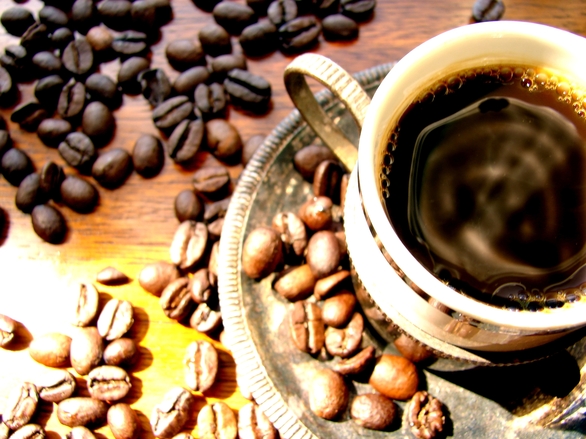Today is National Coffee Day. Tomorrow is International Coffee Day. But for java junkies like myself, every day is coffee day. Here’s a fresh cup of some tasty coffee-related etymologies.

Coffee
The Oxford English Dictionary (OED) first attests coffee in 1598. Some etymologists have linked coffee to Kaffa, the Ethiopian region where coffee was first grown. But the word actually appears to derive from the Arabic qahwah, which may have originally meant “wine.” Some basic meaning of “brew” might explain the sense development. The OED notes that the root of this qahwah is a verb, qahiya, “to have no appetite,” which coffee and wine lovers will agree is absolutely preposterous. The Turkish kahveh , borrowed from the Arabic, influenced the spelling and pronunciation of coffee in its many European cognates (e.g., café).
Espresso
In Italian, espresso literally means “pressed out,” alluding to how the strong, dark drink is produced under stream pressure. English has been sipping espresso since 1945. And don’t feel too bad if you’ve been called out for pronouncing espresso with an x: the English express is essentially the same word as espresso, from the Latin exprimere, “to push out.”
Latte
US speakers shortened latte from caffè latte (1840s) in the late 1980s. It’s Italian for “milk coffee.” Café au lait and café con leche are the respective French and Spanish equivalents. Lait, leche, and latte are all poured from Latin’s lac, which also gives English the words lactate and even lettuce. The Greek cousin of lac is seen in galaxias, literally “milky circle,” hence Milky Way and galaxy. Coffee is truly of cosmic proportions.
Machiatto
A caffè macchiatto is a “stained coffee,” as it’s espresso served with just a spot of hot or foamed milk. In Italian, macchia means “spot” or “blemish,” from the Latin macula for the same. Something that’s immaculate, then, is the etymological opposite of a macchiato. But like latte, both caffè macchiatto and the abbreviated macchiatto have been tasting immaculate on English-speaking lips since the 1980s.
Cappuccino
The color of a cappuccino, apparently, resembles the brown hoods of the Capuchin monks. These friars indeed take their name from the distinctive “hooded cloaks,” or capuccio or capuche in Italian, they wear. These words come from the Latin Latin cappa, source of cap, cape, escape, chapel, and even a capella. The word was served up in English, according to the OED, by 1948, when author Robert O’Brien described the beverage as “gray, like the robe of a capuchin monk.” Brown? Gray? Whatever the case, cappuccino makes for a truly beautiful color.
Mocha
The word coffee may or may not hail from Kaffa, but mocha indeed comes from Mokha, the Red Sea coastal city in Yemen and historically important marketplace for coffee. Mocha coffee, now associated with the addition of chocolate to a latte, has been delighting English speakers since 1773.
Americano
A café Americano is espresso with added hot water – a term that wasn’t intended as a compliment when Central American Spanish started using the term in the 1950s. The description stereotypes an American taste for a milder cup of joe. Perhaps a coffee snob will agree that the americano makes for an inferior cup, but any proper coffee addict will never turn down a good americano – or coffee-inspired word origin.
Bravo! I’lll drink to this! Very interesting, thank you!
LikeLike
A friend of mine ordered my coffee for me on the train from Venice to Rome many years ago. As Aussies, we are used to asking for ‘lattes’. This didn’t pan out very well as I shortly discovered I had been served a tall cup of hot, foamy milk. It would appear the cafe is an essential prefix.
LikeLike
Ha, that’s a fantastic tale – and a reminder to always be specific when ordering your coffee in Italy. Indeed, espresso, latte, and macchiato are both found in English in earlier, and fuller, forms of “caffe espresso,” “caffe latte,” “caffe macchiato,” with the shortened “latte” and “macchiato” especially recent (1980s) or so.
LikeLiked by 1 person
And then of course we have our own versions here – such as long mac and flat white – which completely throw people off
LikeLike
I’m familiar with – and a huge fan of – the flat white, but I don’t know the long mac?!
LikeLiked by 1 person
Long macchiato 🙂
LikeLike
Old-style, no fuss, no muss coffee. Leave the pot on the back burner, heat it up to have a ‘fresh’ cup. When the coffee gets a little weak, just add a few more coffee grounds and some more water, bring it to a boil and have your coffee. When the pot starts to get full of grounds, you might want to dump it out and start over. In hard times just dump part of it!
LikeLike
Well said, sir. Well said!
LikeLike
We actually had a neighbor with a coffee pot like that, on the back of the old cook stove. Truth is stranger than fiction.
LikeLike
Like an old percolator?
LikeLike
Just a old steel pot that was blue at one time, before the percolator was born.
LikeLike